
A genet is a member of the genus Genetta, which consists of 17 species of small African carnivorans. The common genet is the only genet present in Europe and occurs in the Iberian Peninsula, Italy and France.

Pterocarpus angolensis is a species of Pterocarpus native to southern Africa, in Angola, Mozambique, Namibia, South Africa, Eswatini, Tanzania, Democratic Republic of the Congo, Zimbabwe, and Zambia. It is a protected tree in South Africa. The name Kiaat, although Afrikaans, is sometimes used outside South Africa as well. In Zimbabwe, depending on what region you are in, it is known as Mukwa( which it is also called in Zambia) or Mubvamaropa.

Protea eximia, the broad-leaved sugarbush, is a shrub from South Africa that may become a small tree. It occurs in mountain fynbos on mainly acidic sandy soils; the species was very well known under its old name of Protea latifolia. The flowers have awns that are covered in purple-black velvety hairs, and are contained within a series of rings of involucral bracts that have the appearance of petals. The fruit is a densely hairy nut, many of which are inserted on a woody base. The flowers are borne terminally on long shoots, and have a tendency to become very untidy as they age.
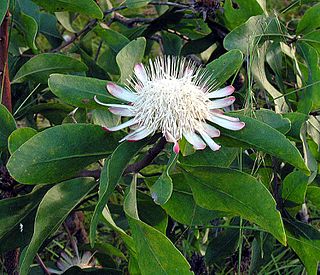
Protea gaguedi is a species of tree which belongs to the genus Protea.

Protea laurifolia, also known as the grey-leaf sugarbush, is a shrub from South Africa. It is native to the Cape Provinces of South Africa.
Leobordea mirabilis is a known species of legume in the family Fabaceae. It is endemic to Namibia. Its natural habitat is rocky areas.
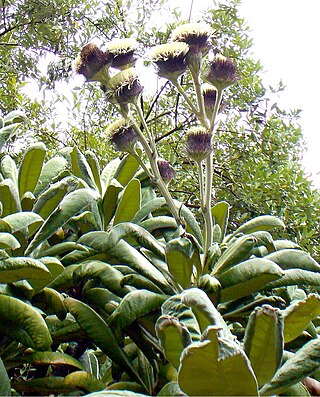
Oldenburgia grandis is a shrub or small, gnarled tree in the family Asteraceae. It occurs in the mountains around Grahamstown in South Africa. It grows to a height of about 5m on sandstone outcrops. It has thick corky bark and large leaves clustered at the ends of branches. The leaves are dark green and leathery, reminiscent of loquat leaves, but generally a good deal larger. The emergent leaves are densely and completely felted with white hair. Most of the felt is lost as the leaf matures, but some persists on under-surfaces. Flowers are white or purplish and borne in large heads some 5- to 12 cm in diameter. The flowerheads are terminal; The same plant may bear solitary heads, plus heads borne in loose, irregular panicles. It is threatened by habitat loss.
Marlothiella gummifera is a species of flowering plant in the family Apiaceae, and the only species in the monotypic genus Marlothiella. It is endemic to Namibia, where its natural habitats are rocky areas and cold desert. It is also the only genus in the tribe Marlothielleae, of the subfamily Apioideae.

Aloe marlothii is a large, single-stemmed Southern African aloe of rocky places and open flat country, occasionally growing up to 6 m tall.

Hoodia juttae is a species of plant in the family Apocynaceae. It is endemic to Namibia. Its natural habitats are rocky areas and cold desert. H. juttae is found around the Little and Great Karas mountains. It is threatened by collection. The plant was discovered by Jutta Dinter, the wife of botanist, Kurt Dinter in 1913. The scientific name refers to Jutta.
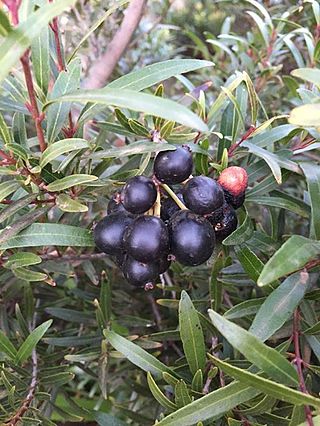
Syzygium pondoense is a species of plants in the family Myrtaceae. It is endemic to South Africa. It is threatened by habitat loss.

Tylecodon is a genus of succulent plants in the family Crassulaceae, native to southern Africa.
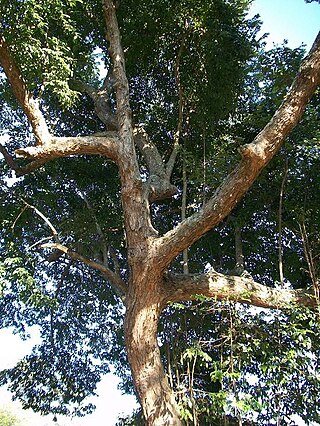
Margaritaria discoidea is a tree in the family Phyllanthaceae, commonly known as the pheasant-berry, egossa red pear or bushveld peacock-berry. These trees are native to the warmer, higher rainfall areas of Africa.

Aloiampelos gracilis, formerly Aloe gracilis, the rocket aloe, is a succulent plant, endemic to dry thicket vegetation around the city of Port Elizabeth, South Africa. Its natural range lies just to the west of the related Aloiampelos ciliaris, and it occurs in bushy fynbos and dry thickets, and clustered on rocky outcrops at all altitudes. Its range extends westwards into the Baviaanskloof mountains.

Diospyros whyteana is a small African tree of the ebony family. Bearing dark green, strikingly glossy leaves and creamy fragrant flowers, it is increasingly cultivated in Southern African gardens as an attractive and strong ornamental tree. It can attain a height of up to 6 m.

Searsia angustifolia, the willow karee or smalblaar, is a small, bushy, evergreen tree which is confined to the South Western Cape in South Africa.

Aloe pearsonii is a very distinctive and unusual species of aloe, that is naturally endemic to the arid Richtersveld area on the border between South Africa and Namibia.
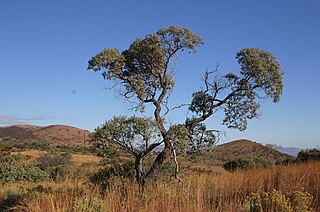
Ozoroa paniculosa, commonly known as the bushveld ozoroa or common resin tree, is a small tree belonging to the mango family or Anacardiaceae. It is native to southern Africa, where it occurs in Zimbabwe, South Africa, Mozambique, Botswana and Namibia. It grows to a height of about 6 metres at high elevations, but may reach 15 metres in warmer, low-lying areas. This genus currently has some 28 species and occurs from southern Africa to the Arabian Peninsula.

Protorhus longifolia, the red beech, is a medium to large, mostly dioecious species of tree in the family Anacardiaceae. It is native to South Africa and Eswatini, where it occurs in well-watered situations from coastal elevations to 1,250 m. The leafy, evergreen trees have rounded crowns and usually grow between 6 and 10 m tall, but regularly taller in forest.
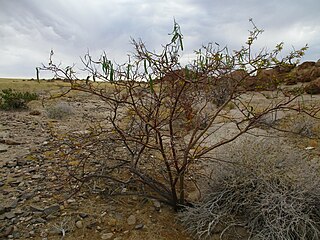
Entada rangei, commonly known as the skew-leaved elephant-root, is a species of flowering plant in the family Fabaceae. It is a deciduous, multi-stemmed shrub or rarely a tree of 4 to 8 meters tall, which may be found on hills as well as plains. The type material was obtained south of Humbe, Angola. E. rangei of southern Namibia is now considered a synonym.





















